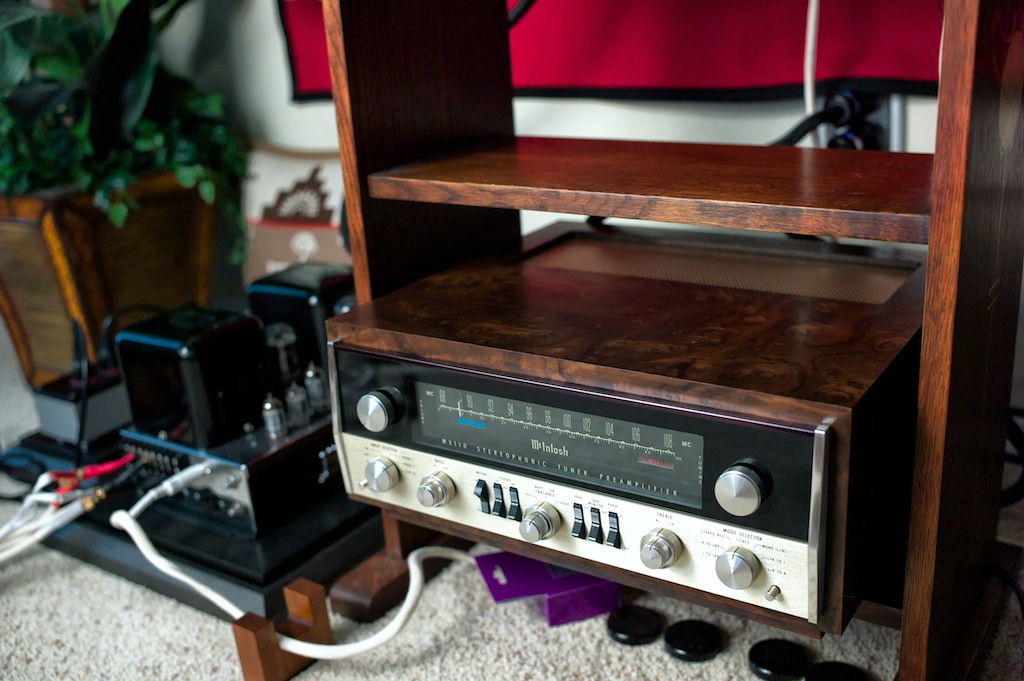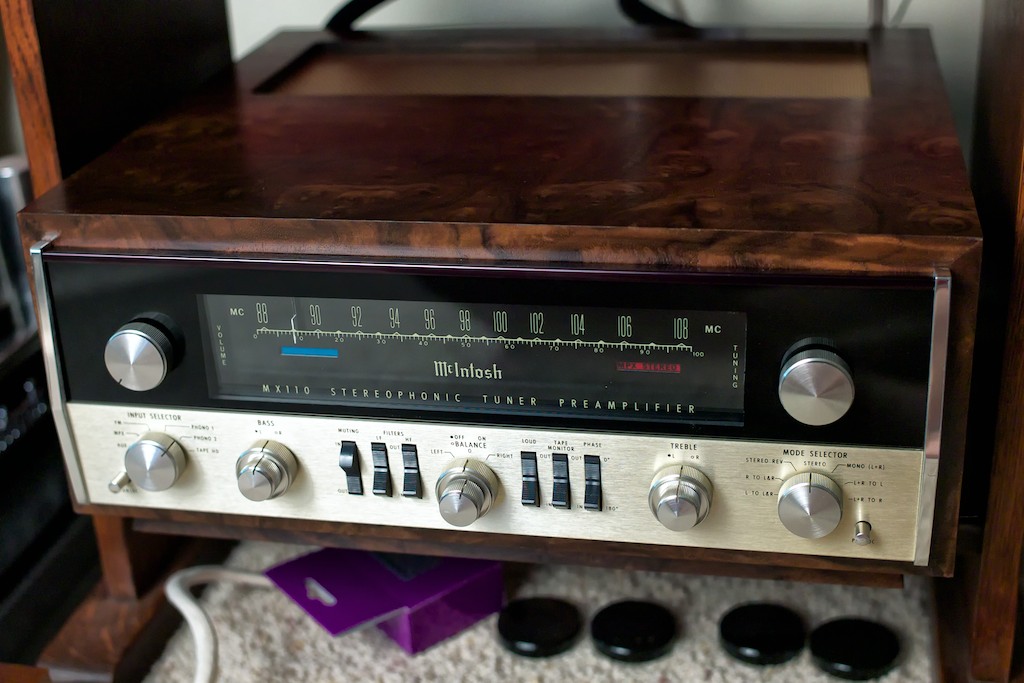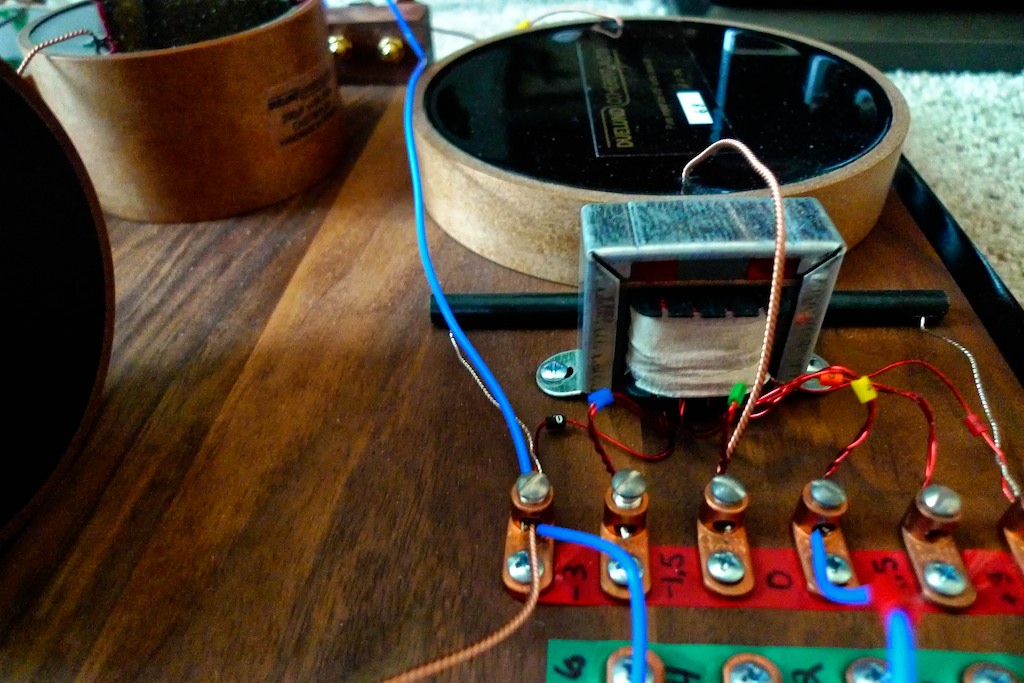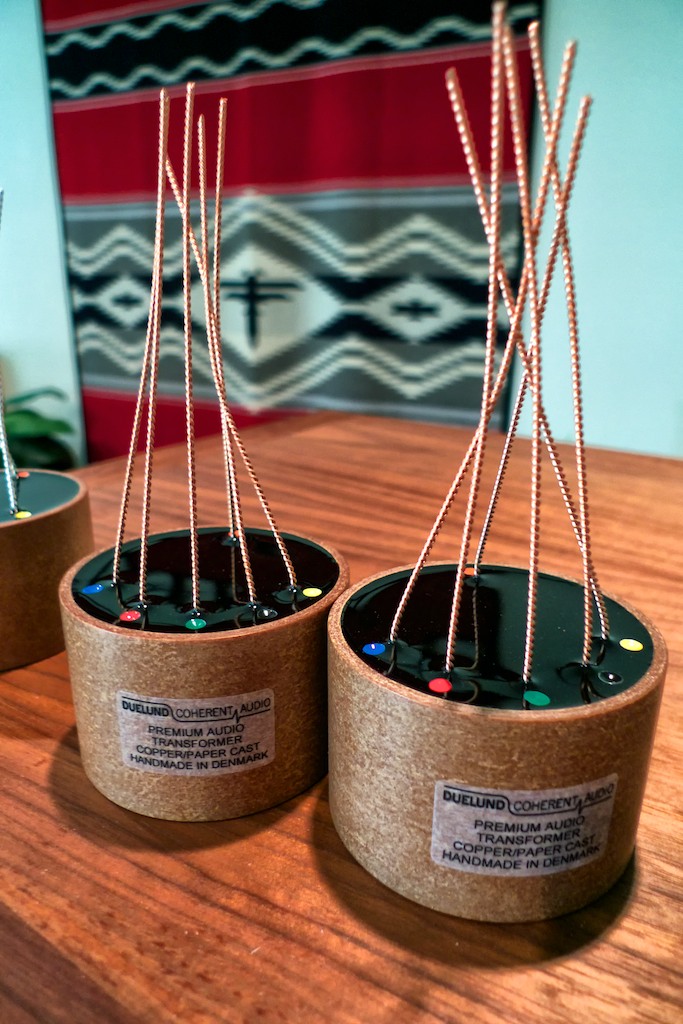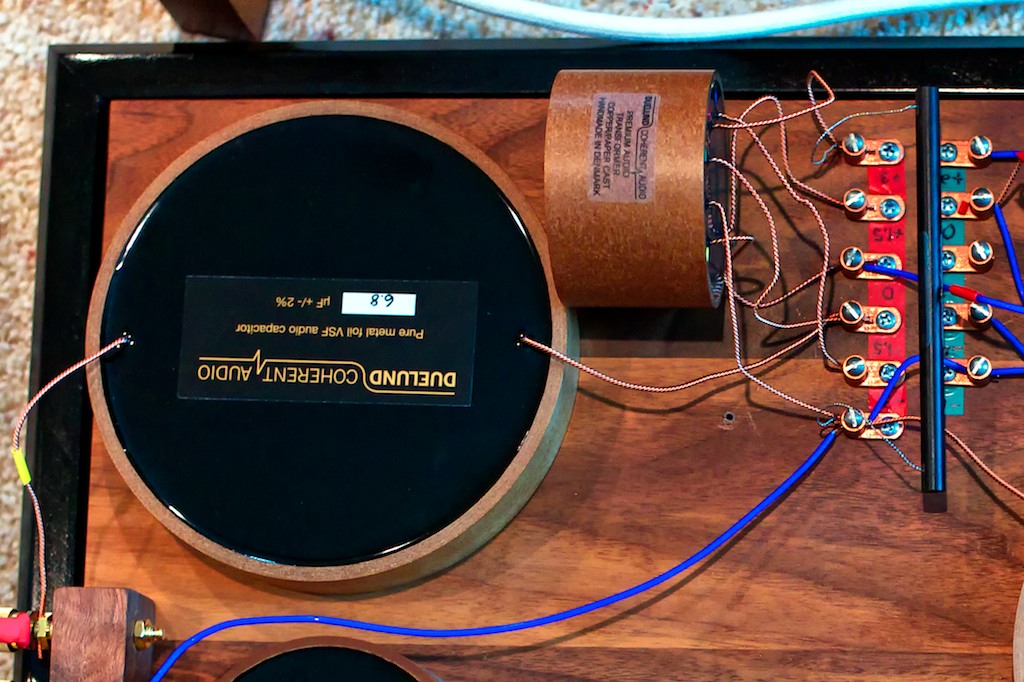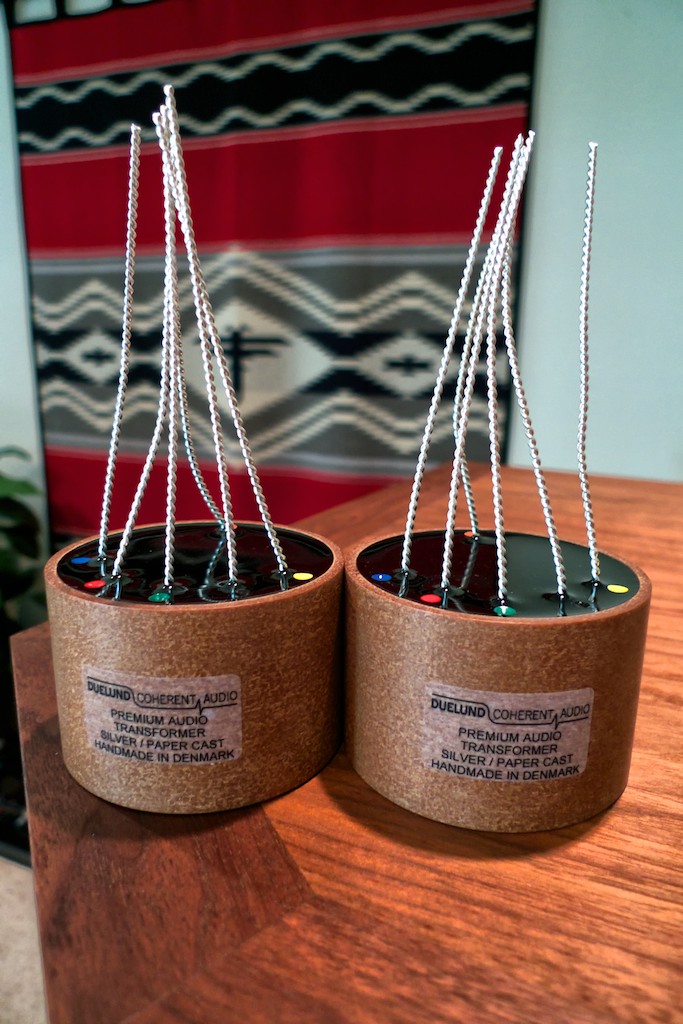Hi Everyone!
Like usual, I've had way too many things going on at once so it has been hard for me to get some new posts up for you.
One of the things I've been wanting to tell you about is some custom McIntosh audio cabinets that I have run across that I think look really sharp with vintage (or new) Mac gear made by Matt & Dan.
I thought the cabinets shown on their web site looked sharp, and I love the 'wood look' with vintage Mac gear, so I sent them an email inquiry:
Hi Matt,
I would like to ask you about building a cabinet for my McIntosh MX110Z tuner/preamplifier. I would like to have a cabinet finished with a walnut burl veneer. Your recommendation for leg style and whether a grill is necessary would be appreciated.
Can you give me an idea of price and delivery timeframe?
Kind regards,
Jeff Day
I asked for walnut burl because I thought it would look nice to match the walnut burl on my Westminster Royal SE loudspeakers. I heard back right away:
Hi Jeff,
For your McIntosh MX110Z the cabinet in regular veneers is $275 with walnut burl wood upgrade it is $100 more for $375, shipping by Fedex insured is $35 for a total of $410.
I have a limited amount of very nice walnut burl wood in stock right now, most of these are built at buyers choice with or with out a screen. While it has tubes they run fairly cool, but if you want a screen there is no additional cost. Leg style is my modified slant legs that is on front and the two sides (back is open for ventilation), the legs are also veneered and finished like rest of cabinet, this is a very sharp look. Current completion time is around 4 weeks after payment.
let me know.
Thanks,
Matt/Dan
I thought that sounded like a fair deal for a custom cabinet, so I placed the order. Four weeks later I had a custom cabinet in walnut burl with a gold screen dropped off at my front door by FedEx.
The cabinet was nicely packed and beautifully made, and included some instructions (and warnings) about waxing and handling the cabinet. Matt & Dan's cabinet fit my MX110Z like the proverbial glove, and I think it looks really sharp, much more so than a nude MX110Z.
The walnut burl and gold screen turned out to be a nice match for the Westminster Royal SE loudspeakers. Next time I have the MX110Z out of the cabinet I'll take some closeup photos from all angles for you to look at.
While it is invisible to most of you, I have been burning the midnight oil writing on The Duelund-WRSE Project Part 2 article for Positive Feedback Online. You'd be amazed at how many hours goes into writing one of these articles, doing the photo shoots, and doing the comparative listening sessions.
I'm at 28 pages of Word text now, and there are 45 photos indexed to the article so far. That's about the half-way point for the article I suppose. The text so far includes an introduction, technical descriptions, and the results of comparative listening sessions to the stock Tannoy autotransformers, the copper Duelund CAST autotransformers, and the silver Duelund CAST autotransformers.
I tried doing something a little different this time, and I am rating everything according to the level of performance according to emotional engagement, audiophile sonics, and musical attributes.
Here's some snippets from the article, although don't consider it cast in stone yet, as I may include edits, and additional insights before I 'freeze' the article for publication:
"Summarizing & Rating Autotransformer Performance
Let me summarize what I’ve found out about in listening sessions with these three sets of autotransformers installed into my Duelund-WRSE outboard high-frequency crossovers.
To help you understand what I’m hearing, I’ll break my summary down into the categories of 1) emotional engagement, 2) musical attributes (the fabric of the music itself, like melody, beat, rhythm, harmonies, loudness, dynamics, timbral realism, tone color resolution, etc.), and audiophile-style sonic attributes (recording artifacts like imaging, soundstage, soundspace, resolution, transparency, etc.).
I’ll even attempt to rate them in these categories in a ten star approach, with one star being not so good, and ten stars being stunning.
The stock Tannoy autotransformers: If I had never heard the Duelund CAST autotransformers I’d think the stock Tannoy autotransformers were pretty wonderful. On simpler music in particular, they’re very emotionally engaging, and they do particularly well on getting the melody, rhythm, beat, and tempos of the music across to the listener, and overall I really enjoyed listening to music through them.
As music gets more complex and demanding, like with the Testament reissues of the Decca live recordings at the 1955 Bayreuth Festival, with Joseph Keilberth conducting, the performance limitations of the stock Tannoy autotransformers becomes more noticeable. Timbre of the strings sounded more wiry and leaner than they do in life, for example, and there was some unpleasant vocal sibilance that could be distracting at times. Tone color was also a little homogenized & bleached, which tended to make the music a little less interesting and emotionally engaging.
Dynamic range – that difference between the quietest and loudest volumes – sounds compressed on the stock Tannoy autotransformers compared to the Duelund autotransformers, with the softest end of the dynamic shadings missing, and the small increments of increases in loudness scaling up to a crescendo are smoothed over, both of which serve to make the music feel less live, and less exciting.
The stock Tannoy autotransformer also tends to lose its composure at loud levels on dynamic peaks by getting harsh, which left me wanting to reach for the volume control of my McIntosh MX110Z to turn things down.
Resolution is not what it could be through the stock Tannoy autotransformers either, making orchestral strings sound homogenized and congested in comparison to the Duelund autotransformers. Small details that are completely audible in a meaningful sort of way with the Duelund autotransformers in the circuit can go completely missing through the Tannoy autotransformers.
From an emotional engagement standpoint I thought the stock Tannoy autotransformers were really good, so I rated them at five out of ten stars. The stock Tannoy autotransformers perform respectably with respect to musical engagement with melodies, beat, and tempos, but fall down on the job in the areas of natural timbre, tone color resolution, dynamics, and loudness, so I rated them three out of ten stars for musical attributes. The stock Tannoy autotransformers are only average in resolution, transparency, and imaging, so I rated them at three out of five stars for sonic attributes.
Emotional engagement (5 ★): ★★★★★
Musical attributes (3 ★): ★★★
Sonic attributes (3 ★): ★★★
The copper Duelund CAST autotransformers: The copper Duelund autotransformers really upset the apple cart when I put them in the high-frequency circuit of my Duelund-WRSE outboard crossovers, because they really laid bare the limitations of my stock Tannoy autotransformers, and there was no going back after that.
What was immediately obvious in my listening sessions was how good sonically the copper Duelund CAST autotransformers were compared to the stock Tannoy autotransformers, particularly as the music got more complex and demanding, as with classical music.
The copper Duelund CAST autotransformers extra resolution and transparency really improved the presentation of classical music, by allowing the individual contributions of the violins, violas, cellos, and basses to be easily discernable, as well as the woodwinds, harps, the brass, the timpani, and the percussion. The copper Duelund CAST autotransformers allowed all of the individual instrument contributions to the orchestral performance to come through in an easily discernable, natural, and very musical way that I found to be really enjoyable. In comparison, the stock Tannoy autotransformers homogenized the contributions of the individual instruments of the orchestra, making the music less interesting and less beautiful.
The timbre of instruments also improved markedly with the copper Duelund CAST autotransformers, with strings, for example, becoming ravishingly beautiful by being rich, rosiny, and natural, whereas with the stock Tannoy autotransformers they sounded lean and wiry in comparison. For classical music lovers the timbral realism that the copper Duelund CAST autotransformers bring to the music is huge in musical dividends.
The copper Duelund CAST autotransformers removed most of the compression of the dynamic range I was hearing with the stock Tannoy autotransformers, with the softer end of the dynamic scale making an appearance, which was completely lost with the stock Tannoys. On the big dynamic swings when the music got loud, the copper Duelund CAST transformers almost always tracked it with ease, allowing me to enjoy the music at natural live-music volume levels without my ears shutting down and making me want to reach for the volume control like they did with the stock Tannoy autotransformers.
Tone color resolution really improved with the copper Duelund CAST autotransformers compared to the stock Tannoy autotransformers, which gave a nice increase in intelligibility of the chordal tone color choices used by musicians in different musical styles, which helped me understand the artistic choices the musicians made in composing and playing their music. For example, it became easier to distinguish what musicians were doing with alterations to three-note triads by adding additional pitches, as with the major & minor 6ths, major & minor 7ths, dominant 7ths with flat or sharp fives or nines, major & minor & dominant 9ths, 11th, augmented 11th, 13th, etc., that give life and meaning to the different styles of music, which are stylistically defined by groupings of tone colors to create their ‘musical feel’ for that particular style of music, which helps musicians craft a certain musical message and emotive feel to go with the music.
After listening to the copper Duelund CAST autotransformers, it was apparent that the stock Tannoy autotransformers blurred, homogenized, bleached, and altered tone colors far more than I had realized. This revelation in tone color resolution is one of the great strengths of all the Duelund components I have had experience with, including the Duelund CAST autotransformers, and this superior presentation of the tone color aspects of the musical fabric is a really big deal for the intended musical message fully getting from the artist to you, the listener.
I already noted that the copper Duelund CAST autotransformers perform significantly better in terms of resolution & transparency compared to the stock Tannoy autotransformers, but they are also significantly better at reproducing recording artifacts like imaging, soundstage, and a sense of soundspace as well. Imaging really improves with the copper Duelund CAST autotransformers, probably as a result of the combination of the increased resolution and transparency they offer. The sense of space in the recording increases dramatically with the copper Duelund CAST autotransformers over the stock Tannoy autotransformers, as does the soundstage, which becomes more expansive in width and depth.
From an emotional engagement standpoint, I only rated the copper Duelund CAST autotransformers one star more than the stock Tannoy autotransformers, at six stars, which I think deserves some additional explanation.
First of all, the stock Tannoy autotransformers are damn good at creating a sense of emotional engagement to the music. With the stock Tannoy autotransformer I found myself laughing, crying, dancing around the room, strutting around like Mick Jagger, or trying to do an occasional moonwalk, to the music – they’re really good from an emotional engagement standpoint.
When it came to engaging melodies, beat, and tempos, the Tannoy is very nearly the match of the copper Duelund CAST autotransformer. Where the copper Duelund CAST autotransformers quickly excelled beyond the stock Tannoy autotransformers in emotional engagement was with classical music, where it pretty much left the Tannoy autotransformers in the dust.
I gave the copper Duelund CAST autotransformers five stars to the Tannoy autotransformers’ three stars, for their superior level of performance in portraying natural & realistic timbre, high levels of tone color resolution, superb rendering of dynamics, and the ability to play loud dynamic peaks without strain. In comparison to the copper Duelund CAST autotransformers, the Tannoy autotransformers had bleached and lean timbre, homogenized tone color resolution, compressed dynamics, and could get shouty if played louder than they were comfortable with.
Sonically the copper Duelund CAST autotransformers are at another level compared to the stock Tannoy autotransformers too, with dramatically better transparency, resolution, imaging, soundstaging (particularly depth), and the ability to convey a larger sense of recorded space that the Tannoy autotransformers can only dream about, and for that I award the Duelunds five stars compared to the Tannoy’s three stars.
Emotional engagement (6 ★): ★★★★★★
Musical attributes (5 ★): ★★★★★
Sonic attributes (5 ★): ★★★★★
The silver Duelund CAST autotransformers: The silver Duelund CAST autotransformers were an ear-opener, and they significantly improved upon all the strengths that I heard in the copper Duelund CAST autotransformers.
The silver Duelund CAST autotransformers were at least as much better, sonically, than the copper Duelund CAST autotransformers were better than the stock Tannoy autotransformers. I’m not talking barely discernible subtleties here, I’m talking big differences: twice as good, five times as good, an order of magnitude better, that sort of range of improvement is what I’m talking about ... "
Ok, there's a sneak peek for you to enjoy! Now it's back to work on the article for Positive Feedback Online!
Thanks for stopping by!





